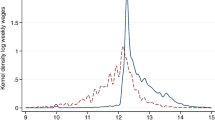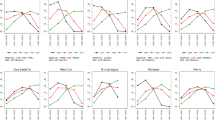Abstract
A simple equilibrium model of sectoral reallocation is developed in order to study the impact of heterogeneous moving costs on unemployment. The model blends key elements of standard sectoral reallocation theory and the competitive search model. Heterogeneity in moving costs is introduced via mobile and immobile workers. The impact of mobile workers on the unemployment rates of mobile and immobile workers is of particular interest. The model shows that the share of mobile workers raises their unemployment rate. The model also shows that when labor mobility is driven by a sectoral level aggregate disturbance, mobile workers can have a non-monotonic, but globally negative impact on the unemployment rate of immobile workers. However, when labor mobility is driven by an idiosyncratic sector-worker match effect, the share of mobile workers raises the unemployment rate of immobile workers.




Similar content being viewed by others
Notes
The interaction of within-sector trading frictions and sectoral mobility is also considered in other studies. For example, Lkhagvasuren (2007, 2012) uses a similar multi-sector setting to analyze local labor market dynamics in the U.S. Carrillo-Tudela and Visschers (2013) develop an equilibrium multi-sector model with within-sector trading frictions to study the cyclicality of sectoral reallocation.
In the model, mobile workers have higher productivity since they move across sectors costlessly. Therefore, by construction, economy-wide employment and the share of mobile workers are positively related. This is not inconsistent with the procyclicality of mobility studied by Moscarini and Thomsson (2007); Kambourov and Manovskii (2009); Lkhagvasuren (2012) and Carrillo-Tudela and Visschers (2013).
In our analysis, we consider ex-ante identical workers and assume that unemployment income b is the same among workers with different productivity shocks. One can allow b to increase with the idiosyncratic productivity shock x to reflect the possibility that more productive workers value leisure more. However, using the results below in Proposition 2, one can see that such a variation in income b is inconsequential for the results, as long as the job-finding rate increases with productivity (see Eq. 35).
In fact, using state-level data, Blanchard and Katz (1992) show that net mobility reduces the impact of an adverse labor demand shock on local unemployment.
References
Blanchard O, Katz L (1992) Regional evolutions. Brook Pap Econ Act 23:1–61
Carrillo-Tudela C, Visschers L (2013) Unemployment and endogenous reallocation over the business cycle. IZA Discussion paper 7124
Coen-Pirani D (2010) Understanding gross worker flows across U.S. States. J Monet Econ 57(7):769–784
Coulson NE, Fisher LM (2009) Housing tenure and labor market impacts: the search goes on. J Urban Econ 65:252–264
Greenwood MJ (1997) Internal migration in developed countries. In: Rosenzweig MR, Stark O (eds) Handbook of population and family economics, vol. 1B. North Holland, New York
Head A, Lloyd-Ellis H (2012) Housing liquidity, mobility, and the labour market. Rev Econ Stud 79
Jovanovic B, Moffitt R (1990) An estimate of a sectoral model of labor mobility. J Polit Econ 98(4):827–852
Kambourov G, Manovskii I (2009) Occupational mobility and wage inequality. Rev Econ Stud 76:731–759
Lkhagvasuren D (2007) Local labor market dynamics with net and gross mobility: implications on unemployment and wages. Ph.D. thesis. University of Rochester
Lkhagvasuren D (2012) Big locational unemployment differences despite high labor mobility. J Monet Econ 59(8):798–814
Lucas RE Jr, Prescott EC (1974) Equilibrium search and unemployment. J Econ Theory 7:188–209
Moen ER (1997) Competitive search equilibrium. J Polit Econ 105(2):385–411
Mortensen DT, Nagypál É (2007) More on unemployment and vacancy fluctuations. Rev Econ Dyn 10(3):327–347
Moscarini G, Thomsson K (2007) Occupational and job mobility in the US. Scand J Econ 109:807–836
Moscarini G, Vella F (2008) Occupational mobility and the business cycle, Working paper 13819, NBER
Munch JR, Rosholm M, Svarer M (2006) Are homeowners really more unemployed?Econ J 116(514):991–1013
Oswald A (1997) Thoughts on NAIRU (correspondence). J Econ Perspect 11(1):227–228
Oswald A (1999) The housing market and europe’s unemployment: A non-technical paper. Warwick University, Mimeo
Petrongolo B, Pissarides CA (2001) Looking into the black box: a survey of the matching function. J Econ Lit 39(2):390–431
Rogerson R (1987) An equilibrium model of sectoral reallocation. J Polit Econ 95(4):824–834
Rogerson R, Shimer R, Wright R (2005) Search theoretic models of the labor market: A survey. J Econ Lit 43(4):959–988
Rogerson R, Visschers LP, Wright R (2009) Labor market fluctuations in the small and in the large. Int J Econ Theory 5(1):125–137
Topel RH (1986) Local labor markets. J Polit Econ 94(3):S111—S143
Valletta RG (2012) House lock and structural unemployment. IZA Discussion paper 7002
Acknowledgments
We would like to thank an anonymous referee, Mark Bils, Effrosyni Diamantoudi, Gordon Fisher and David Fuller for helpful comments and suggestions.
Author information
Authors and Affiliations
Corresponding author
Rights and permissions
About this article
Cite this article
Lkhagvasuren, D., Nitulescu, R. Sectoral Mobility and Unemployment with Heterogeneous Moving Costs. J Labor Res 34, 339–358 (2013). https://doi.org/10.1007/s12122-013-9163-3
Published:
Issue Date:
DOI: https://doi.org/10.1007/s12122-013-9163-3
Keywords
- Sectoral unemployment
- Aggregate unemployment
- Island model
- Competitive search
- Net and gross mobility
- homeownership
- Aging population




